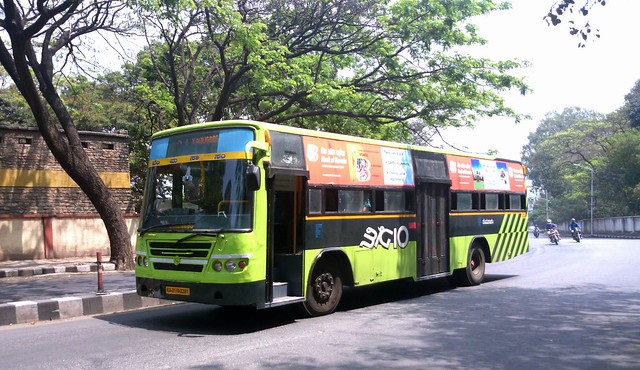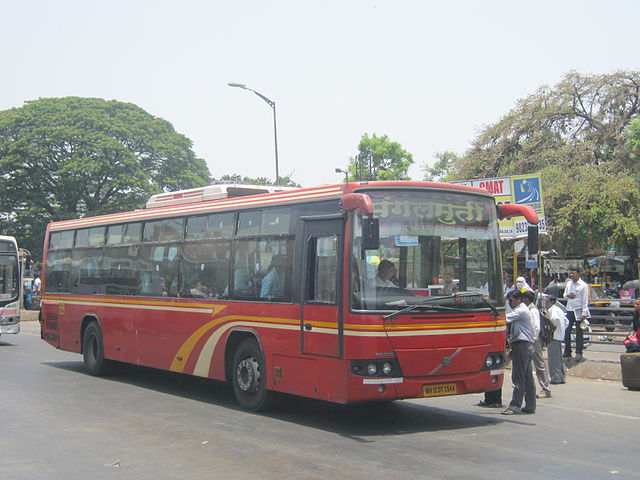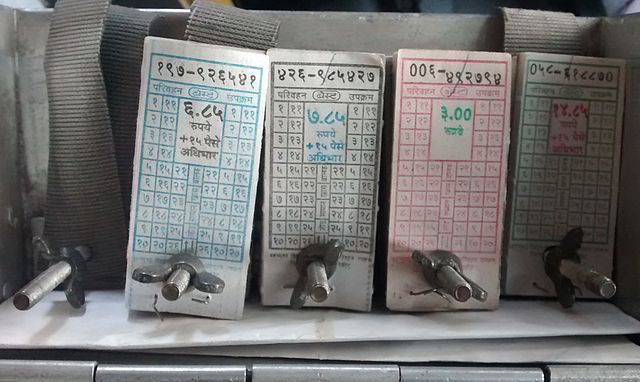Back in July 2015, BEST had announced that it had plans to operate buses without conductors in South Bombay on an experimental basis. The first thing that came to my mind was the BMTC Pushpak fleet. Thankfully, BEST was not emulating BMTC, but emulating its younger Maharashtrian sibling MSRTC, which has so far been super successful in the field of operating buses without conductors.
So what exactly is the difference? To the layman, a bus without a conductor, is a bus without a conductor. There is a major difference between the two, one that spells the difference between efficiency and incompetence. Let us examine the difference between the two and examine the flaws of each:
The BMTC Model
The most prominent of the BMTC no-conductor buses is the Pushpak. Originally a brown-coloured, single-door bus, with a variant of it, called the Pushpak+ with a green livery and an additional centre-door seen these days, they are seen on a lot of routes across Bangalore. A lot of them are also leased out by BMTC to IT giants and others. Another peculiar feature of these buses is that they do not feature the regular 2+2 pattern of seating normally followed in city buses, but have 3 seats per row, on the right hand side, behind the driver. The driver of this bus collects the fare, hands over change (if any), issues the ticket, and if he doesn’t have change, he writes it on the back of the ticket. Thankfully, unlike their BEST counterparts [no pun intended], BMTC conductors just tear the ticket halfway and hand them over. But imagine, doing this for each passenger! As if this was not bad enough, due to the seating pattern in the bus, the walkway width is reduced, and only one passenger can walk across. With only one door, you can imagine what could possibly happen when you reach a bus stop. People have to board, people have to disembark, people have to buy tickets, or passes, show their passes. The driver is overburdened with all this, and has an additional headache- He still has to drive the bus! The time taken at each bus stop becomes a huge figure, resulting in longer commute time and lesser fuel efficiency. Add Bangalore’s narrow roads, badly located bus stops, bumper-to-bumper traffic to this and wallah, you have the perfect recipe for a Traffic Jam! The only possible positive outcome of this mess is that BMTC doesn’t have a conductor on this bus, which would probably save them some cash.
A similar model existed back in 2008-9, where green-coloured buses labelled “Pass Bus” would ply. These buses were also single-door, devoid of a conductor, but had one interesting feature- No tickets (or passes) were sold. Only pass holders, be it daily, weekly, monthly, students, senior citizens were allowed. BMTC later on started selling daily passes on these buses, adding to the drivers burden. They were later given a rear door, a conductor and painted in the blue-off white colour scheme and became regular buses. BMTC probably realised that there was no point in running services that didn’t generate any revenue while on a trip.
The MSRTC Model
This model started off a decade ago with the Shivneri series. Originally only on the Dadar East – Pune Railway Station route, it has since been extended 113 other routes as well as the Hirkani/Asiad and Parivartan buses. In this model, MSRTC has bus booths at several places, like Khodadad Circle in Dadar, where the Bus Terminus is the lane under the flyover, between its pillars, or Maitri Park in Chembur, Wakad in Pimpri-Chinchwad, or Nigdi on the Old Mumbai-Pune Highway. A conductor sits at these booths, with a Trimax electronic ticket machine. When the bus arrives, he or she punches in the bus number onto the ETM, which automatically brings up the departure time onto the ETM, as well as seats left. To prevent error, they also check the trip sheet with the driver, and after selling tickets, log it onto the sheet so that the next conductor, if there is any other stop en route, can cross-check with it. This model existed even in the time of the Punched Paper ticket. The buses here are the same as the buses with conductors in them. For instance, the Swargate – Borivali Shivneri has a conductor due to number of stops it has on the Western Express Highway. MSRTC benefits here mainly because of the fact that buses run faster due to fewer stops, and it has to employ fewer conductors. Of course, conductors themselves are not too enthused by the move. In the long run, this impacts the organisational health of ST in a positive way, which is good for both commuters and staff.
Now, coming to BEST
BEST intends to run these buses on four routes:
- Special 1 – CST <-> NCPA
- Special 2 – CST <-> World Trade Centre
- Special 8 – Churchgate <-> Churchgate via World Trade Centre
- Special 9 – Churchgate <-> Churchgate via Nariman Point
These buses will operate on the MSRTC model, with conductors at the bus stops, especially given that these are short routes. Now, my main concern here is that if there are 10 stops, will BEST have a conductor at each of the ten stops? Also, more importantly, will it provide seating and shelter arrangements to the conductors? You can’t expect them to stand for hours with the heat, pollution and traffic. One may argue that here, the BMTC model would be better as conductors wouldn’t be waiting on busy roads, but do remember, making the driver do all the work isn’t such a good idea altogether.
Now, the funny part is that BEST says that it has sent a proposal to the Government of Maharashtra to allow buses without conductors as this is prohibited under the Motor Vehicles Act, 1988. Now, the MVA is a pan-India law, and thus, if it is illegal in Maharashtra, for a Stage Carrier/Stage Coach to operate without a driver, then has BMTC been violating the law jeopardising the lives of commuters all this time? However, the interesting point is that as per the Motor Vehicles Act of 1988, there two clauses which are interesting:
The first, which allows the driver to temporarily take charge as conductor:
the conditions subject to which drivers of stage carriages performing the functions of a conductor and persons temporarily employed to act as conductors may be exempted from the provisions of sub-section (1) of section 29;
and the second, which implies that a conductor is not needed:
Duty of the driver to take certain precautions at unguarded railway level crossing. Every driver of a motor vehicle at the approach of any unguarded railway level crossing shall cause the vehicle to stop and the driver of the vehicle shall cause the conductor or cleaner or attendant or any other person in the vehicle to walk up to the level crossing and ensure that no train or trolley is approaching from either side and then pilot the motor vehicle across such level crossing, and where no conductor or cleaner or attendant or any other person is available in the vehicle, the driver of the vehicle shall get down from the vehicle himself to ensure that no train or trolley is approaching from either side before the railway track is crossed.
Confusing, isn’t it? If indeed, buses without conductors weren’t permitted, then BEST should be sending a proposal to the Ministry of Road Transport and Highways [Morth], Government of India and this ideally shouldn’t be a problem, since the Minister is Nitin Gadkari. At the same time, this would also imply that BMTC is violating the law by plying buses without a conductor, even if Karnataka has a law since Central Law usually overrides State Law if they are in conflict. I’m hoping for a lawyer to clarify on this below.
So now, the pros and cons:
Pros:
- Money saved by employing fewer conductors.
- Time Saved because you have to have fewer stops.
Cons:
- You need to reduce the number of stops.
- You need to make special arrangements for the conductor while waiting for the bus to arrive.
This model will definitely work with BEST because there is no reservation or booking of seats involved and because, well, the Trimax ETMs.
![]()







